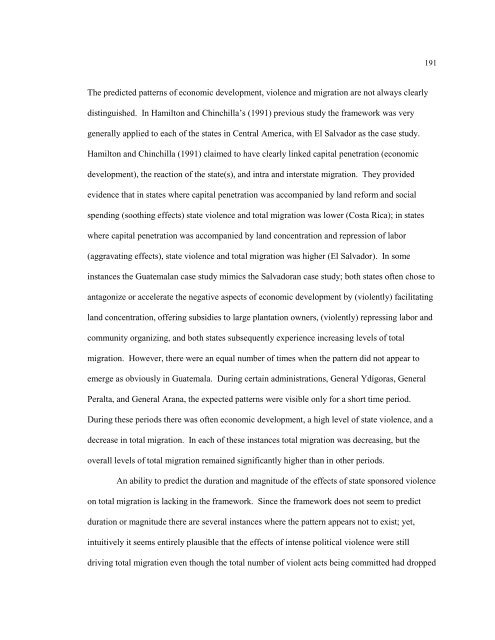Complete Thesis_double spaced abstract.pdf
Complete Thesis_double spaced abstract.pdf
Complete Thesis_double spaced abstract.pdf
You also want an ePaper? Increase the reach of your titles
YUMPU automatically turns print PDFs into web optimized ePapers that Google loves.
The predicted patterns of economic development, violence and migration are not always clearly<br />
distinguished. In Hamilton and Chinchilla’s (1991) previous study the framework was very<br />
generally applied to each of the states in Central America, with El Salvador as the case study.<br />
Hamilton and Chinchilla (1991) claimed to have clearly linked capital penetration (economic<br />
development), the reaction of the state(s), and intra and interstate migration. They provided<br />
evidence that in states where capital penetration was accompanied by land reform and social<br />
spending (soothing effects) state violence and total migration was lower (Costa Rica); in states<br />
where capital penetration was accompanied by land concentration and repression of labor<br />
(aggravating effects), state violence and total migration was higher (El Salvador). In some<br />
instances the Guatemalan case study mimics the Salvadoran case study; both states often chose to<br />
antagonize or accelerate the negative aspects of economic development by (violently) facilitating<br />
land concentration, offering subsidies to large plantation owners, (violently) repressing labor and<br />
community organizing, and both states subsequently experience increasing levels of total<br />
migration. However, there were an equal number of times when the pattern did not appear to<br />
emerge as obviously in Guatemala. During certain administrations, General Ydígoras, General<br />
Peralta, and General Arana, the expected patterns were visible only for a short time period.<br />
During these periods there was often economic development, a high level of state violence, and a<br />
decrease in total migration. In each of these instances total migration was decreasing, but the<br />
overall levels of total migration remained significantly higher than in other periods.<br />
An ability to predict the duration and magnitude of the effects of state sponsored violence<br />
on total migration is lacking in the framework. Since the framework does not seem to predict<br />
duration or magnitude there are several instances where the pattern appears not to exist; yet,<br />
intuitively it seems entirely plausible that the effects of intense political violence were still<br />
driving total migration even though the total number of violent acts being committed had dropped<br />
191














![Completed Thesis to Grad Studies[Final3].pdf](https://img.yumpu.com/17538645/1/190x245/completed-thesis-to-grad-studiesfinal3pdf.jpg?quality=85)
